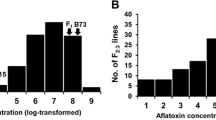Abstract
Aflatoxins are carcinogenic and toxic metabolites produced by the fungus Aspergillus flavus during infection of maize (Zea mays L.) and other seed oil crops. Climatic conditions in the southeastern United States favor A. flavus infection and aflatoxin contamination in maize, making it a major issue for farmers in the region. One of the most promising avenues to combat aflatoxin contamination is the development of resistant maize lines. However, this has proven difficult due to a lack of reliable markers for resistance. Previous studies have identified candidate genes that were differentially expressed in response to A. flavus infection. One gene, encoding a chloroplast precursor, was found to contain multiple polymorphisms that were used to design a marker designated Mississippi Marker 1 (MpM1). The marker differentiates between the “resistance” and “susceptible” forms of the allele. This marker was used to screen three populations of F2:3 mapping families, where it was found to map to chromosome 4 and was associated with a significant effect for resistance to aflatoxin accumulation in the Mp313E × B73 mapping population. Furthermore, the marker MpM1 identified a previously unknown quantitative trait loci for resistance to aflatoxin accumulation on maize chromosome 4. MpM1 is the first gene-based marker developed specifically for resistance to aflatoxin accumulation in maize and can now be integrated into existing marker assisted selection programs aimed at incorporating resistance into elite maize breeding lines.





Similar content being viewed by others
References
Ayeh KW (2008) Expressed sequence tags (ESTs) and single nucleotide polymorphisms (SNPs): emerging molecular marker tools for improving agronomic traits in plant biotechnology. Afr J Biothechnol 7:331–341
Brooks T, Williams W, Windham G, Wilcox M, Abbas H (2005) Quantitative trait loci contributing resistance to aflatoxin accumulation in the maize inbred Mp313E. Crop Sci 45:171–174
Campbell KW, White DG (1995) Evaluation of corn genotypes for resistance to Aspergillus ear rot, kernel infection, and aflatoxin production. Plant Dis 79:1039–1045
Castegnaro M, McGregor D (1998) Carcinogenic risk assessment of mycotoxins. Rev Med Vet 149:671–678
Ching A, Caldwell KS, Jung M, Dolan M, Smith OS, Tingey S, Morgante M, Rafalski AJ (2002) SNP frequency, haplotype structure and linkage disequilibrium in elite maize inbred lines. BMC Genet 3:19. doi:10.1186/1471-2156-3-19
Davis GL, Windham GL, Williams WP (1999) QTL mapping of genes that influence aflatoxin B1 level. Maize genetics conference: abstract 40
Gupta PK, Roy JK, Prasad M (2001) Single nucleotide polymorphisms: a new paradigm for molecular marker technology and DNA polymorphism detection with emphasis on their use in plants. Curr Sci India 80:524–535
Kelley RY, Williams WP, Mylroie JE, Boykin DL, Hawkins LK, Windham GL, Brooks TD, Bridges SM, Scheffler BE, Wilkinson JR (2009) Genomic profile of maize response to Aspergillus flavus infection. Toxin Rev 28:129–141
Mammadov J, Chen W, Mingus J, Thompson S, Kumpatla S (2011) Development of versatile gene-based SNP assay in maize (Zea mays L.). Mol Breeding. doi:10.1007/s11032-011-9589-3
Moreno O, Kang M (1999) Aflatoxins in maize: the problem and genetic solutions. Plant Breeding 118:1–16
Mysore KS, D’Ascenzo MD, He X, Martin GB (2003) Overexpression of the disease resistance gene pto in tomato induces gene expression changes similar to immune responses in human and fruitfly. Plant Physiol 132:1901–1912
Park DL, Liang B (1993) Perspectives on aflatoxin control for human food and animal feed. Trends Food Sci Tech 4:334–342
Paul C, Naidoo G, Forbes A, Mikkilineni V, White D, Rocheford T (2003) Quantitative trait loci for low aflatoxin production in two related maize populations. Theor Appl Genet 107:270–363
Rafalski A (2002) Applications of single nucleotide polymorphisms in crop genetics. Curr Opin Plant Biol 5:94–100
Rozen S, Skaletsky HJ (2000) Primer3 on the WWW for general users and for biological programmers. In: Krawetz S, Misener S (eds) Bioinformatics methods and protocols: methods in molecular biology. Humana Press, Clifton, p 365–386
Scott G, Zummo N (1988) Sources of resistance in maize to kernel infection by Aspergillus flavus in the field. Crop Sci 28:504–507
Scott G, Zummo N (1990) Registration of Mp313E parental line of maize. Crop Sci 30:1378
Scott G, Zummo N (1992) Registration of Mp420 germplasm line of maize. Crop Sci 32:1296
Somssich IE, Hahlbrock K (1998) Pathogen defense in plants—a paradigm of biological complexity. Trends Plant Sci 3:86–90
Vardon P, McLaughlin C, Nardinelli C (2003) Potential economic costs of mycotoxins in the United States. In: Richard JL, Payne GA (eds) Mycotoxins: risks in plant, animal, and human systems. Task force report no. 139. Ames, IA: Council for Agricultural Technology
Warburton ML, Brooks TD, Krakowsky MD, Shan X, Windham GL, Williams WP (2009) Identification and mapping of new sources of resistance to aflatoxin accumulation in maize. Crop Sci 49:1397–1402
Warburton ML, Brooks TD, Windham GL, Williams WP (2010) Identification of novel QTL contributing resistance to aflatoxin accumulation in maize. Mol Breeding 27:491–499. doi:10.1007/s11032-010-9446-9
Willcox MC, Davis GL, Warburton ML, Windham GL, Abbas HK, Betrán J, Holland JB, Williams WP (2013) Confirming QTL for aflatoxin resistance from Mp313E in different genetic backgrounds. Mol Breeding 32(1):15–26
Williams P, Windham G (2001) Registration of maize germplasm line Mp715. Crop Sci 41:1374–1375
Williams P, Windham G (2006) Registration of maize germplasm line Mp717. Crop Sci 46:1407
Williams P, Windham G, Buckley P (2003) Enhancing maize germplasm with resistance to aflatoxin accumulation. Toxin Rev 22:175–193
Windham GL, Williams WP (2002) Evaluation of corn inbreds and advanced breeding lines for resistance to aflatoxin contamination in the field. Plant Dis 86:232–234
Acknowledgments
The authors would like to thank Jack Haynes, Rowena Kelley, Sam Abbas, Renuka Shivaji, and especially W. Paul Williams for their technical assistance and guidance. This research was funded through a specific cooperative agreement with the USDA-ARS Corn Host Plant Resistance Research Unit and the Mississippi Agricultural and Forestry Experiment Station, Mississippi State University.
Author information
Authors and Affiliations
Corresponding author
Rights and permissions
About this article
Cite this article
Mylroie, J.E., Warburton, M.L. & Wilkinson, J.R. Development of a gene-based marker correlated to reduced aflatoxin accumulation in maize. Euphytica 194, 431–441 (2013). https://doi.org/10.1007/s10681-013-0973-4
Received:
Accepted:
Published:
Issue Date:
DOI: https://doi.org/10.1007/s10681-013-0973-4



